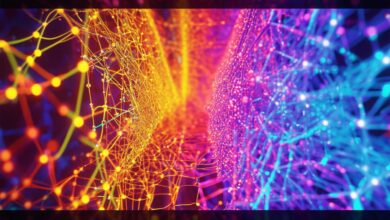
Neural Machine Translation (NMT)
Neural Machine Translation (NMT) uses deep learning for translating text between languages. NMT relies on neural networks that process source and target languages. The process involves encoding the source sentence into a vector representation and decoding it into the target language.
A key component in NMT is the encoder-decoder architecture. An encoder processes the input sequence and converts it into a context vector. The decoder then uses this vector to produce the translated sentence. This method captures long-range dependencies within sentences.
Attention mechanisms enhance NMT by allowing the model to focus on different parts of the input sentence when generating each output word. This dynamic focus allocation improves translation accuracy and fluency.
NMT models, like the Transformer, have enhanced translation quality. Transformers use self-attention mechanisms to process input data, efficiently handling varying sentence lengths and complexities.
Key Features of NMT:
- Flexibility in handling large vocabularies
- Rare word processing through subword tokenization (e.g., Byte Pair Encoding)
- Substantial computational power requirements
- Large dataset training for parameter fine-tuning
NMT has improved various applications beyond text translation. Systems like Google Translate use NMT to provide real-time translation with higher accuracy compared to previous implementations1.
Unsupervised Machine Translation (UMT) Techniques
Unsupervised Machine Translation (UMT) Techniques have transformed language translation, especially where parallel datasets are scarce. Unlike traditional methods relying on curated datasets of sentence pairs, UMT uses innovative techniques such as cross-lingual word embedding and monolingual data.
Key Components of UMT:
- Cross-lingual word embedding: Creates vector representations of words in different languages within a shared space.
- Monolingual data utilization: Crucial for training UMT models.
- Backtranslation: A prominent technique for creating pseudo parallel corpora.
UMT's potential in addressing low-resource language challenges is significant. It enables translation systems that can connect these low-resource languages with more widely spoken ones. This approach democratizes access to translation technology.
"UMT excels at handling data scarcity problems. By exploiting monolingual data's inherent structure and statistical properties, UMT models can generate meaningful translations even without aligned sentence pairs."
The unsupervised nature of UMT supports endangered language preservation and revitalization. It provides a framework for developing translation models that can assist in documenting and translating texts from languages nearing extinction2.
Semi-supervised Machine Translation
Semi-supervised machine translation (SSMT) combines supervised methods with unsupervised techniques. This hybrid approach is useful when parallel corpora are limited but monolingual data is abundant.
SSMT Process:
- Initial supervised learning phase using available parallel corpora
- Refinement using unsupervised techniques (e.g., backtranslation)
- Alternating between parallel and monolingual data for training
Incorporating monolingual data is crucial to SSMT's success. It addresses limitations posed by parallel corpora scarcity. By alternating between parallel and monolingual data, SSMT uses all available information, balancing precision and generalization.
The semi-supervised approach offers flexibility that purely supervised or unsupervised methods can't match. It allows fine-tuning the balance between supervised and unsupervised phases based on data availability for specific language pairs.
SSMT's adaptability extends to different languages and domains. This approach can be adjusted to specific needs by changing the ratio of supervised to unsupervised training phases.
Another advantage is the ability to incrementally improve with additional data inputs. As more parallel and monolingual data become available, the SSMT model can be retrained and fine-tuned continuously, ensuring ongoing translation quality improvement without complete retraining3.
Challenges and Solutions in Arabic Dialect Translation
Arabic dialect translation presents unique challenges due to its linguistic features, such as word concatenation, character repetition for emphasis, and lexical differences from Modern Standard Arabic (MSA).
Key Challenges and Solutions:
| Challenge | Solution |
|---|---|
| Word concatenation | Advanced tokenization techniques |
| Character repetition for emphasis | Normalization techniques during pre-processing |
| Lexical differences from MSA | Combination of large monolingual corpora and parallel data |
Rule-based approaches can explicitly encode transformation rules from dialectal to standard Arabic. These rules can include morphological transformations, syntactic adjustments, and lexical substitutions. Although labor-intensive to develop, rule-based systems can serve as a solid baseline.
Unsupervised learning and semi-supervised machine translation can enhance Arabic dialect translation quality. By using backtranslation and leveraging monolingual data in both the dialect and MSA, models can iteratively refine their translations.
Combining these techniques allows translation models to become more adept at understanding and translating Arabic dialects. Through integrating advanced tokenization, normalization, and leveraging both rule-based systems and machine learning approaches, significant improvements can be achieved4.

Performance Evaluation: BLEU Score
The Bilingual Evaluation Understudy (BLEU) score is an important metric for assessing machine translation quality. Developed by IBM in 2002, BLEU measures how closely a machine-generated translation matches a human-created reference translation. This metric provides an objective and automated method to evaluate translation accuracy and fluency.
BLEU assesses translated text by comparing it to one or more reference translations. It calculates the overlap of n-grams (subsequences of n words) between the machine translation and the reference translation. A higher overlap indicates a better translation. BLEU considers both precision (how many of the machine's n-grams are in the reference) and a brevity penalty to account for excessively short translations.
BLEU Score Formula
The BLEU score is computed using the following formula:
BLEU = BP × exp((1/N) ∑(n=1 to N) log p_n)
Where:
- BP is the brevity penalty
- N is the maximum length of n-grams (usually up to 4)
- p_n is the precision of n-grams of length n
Brevity Penalty
The brevity penalty BP is calculated to discourage overly short translations and is defined as:
BP = 1, if c > r
BP = exp(1 - r/c), if c ≤ r
Here, c is the length of the candidate translation, and r is the length of the reference translation, chosen as the closest length among the references to the candidate.
Precision Calculation
The precision p_n for each n-gram length is computed as follows:
p_n = ∑(count)(matched n-grams) / ∑(count)(candidate n-grams)
This measures the proportion of n-grams in the candidate translation that are also present in the reference translation. However, it only rewards exact matches, which can be a limitation when dealing with synonymous phrases or different valid structural variations.
"BLEU's focus on precision rather than recall, combined with its geometric averaging, helps mitigate the risk of overly fluent but inaccurate translations."
The BLEU score ranges from 0 to 1, where 1 indicates a perfect match with the reference. In practice, scores are typically presented as a percentage (ranging from 0 to 100) for easier interpretation.
Limitations of BLEU
Despite its widespread use, BLEU has limitations:
- May not fully account for the quality of synonyms or paraphrases
- Doesn't consider linguistic phenomena like word order and grammatical correctness beyond surface-level n-gram matches
- Often supplemented with other metrics and human judgment for a more comprehensive evaluation
BLEU serves as a standardized measure, enabling consistent comparison across different models and driving continuous improvement of translation algorithms in NMT, UMT, and SSMT frameworks.
Neural Machine Translation (NMT)
Neural Machine Translation has significantly improved the accuracy and fluency of translations. By using neural networks and attention mechanisms, it offers a sophisticated approach to understanding and replicating complex linguistic structures. This makes NMT a powerful tool in modern machine translation.
Key features of NMT include:
- End-to-end learning
- Contextual understanding
- Attention mechanisms
- Ability to handle long-range dependencies
These features allow NMT systems to produce more natural and accurate translations compared to their predecessors. The use of deep learning techniques has enabled NMT to capture nuances in language that were previously challenging for machine translation systems.

Writio: Your AI content writer for website publishers and blogs. This article was written by Writio.







